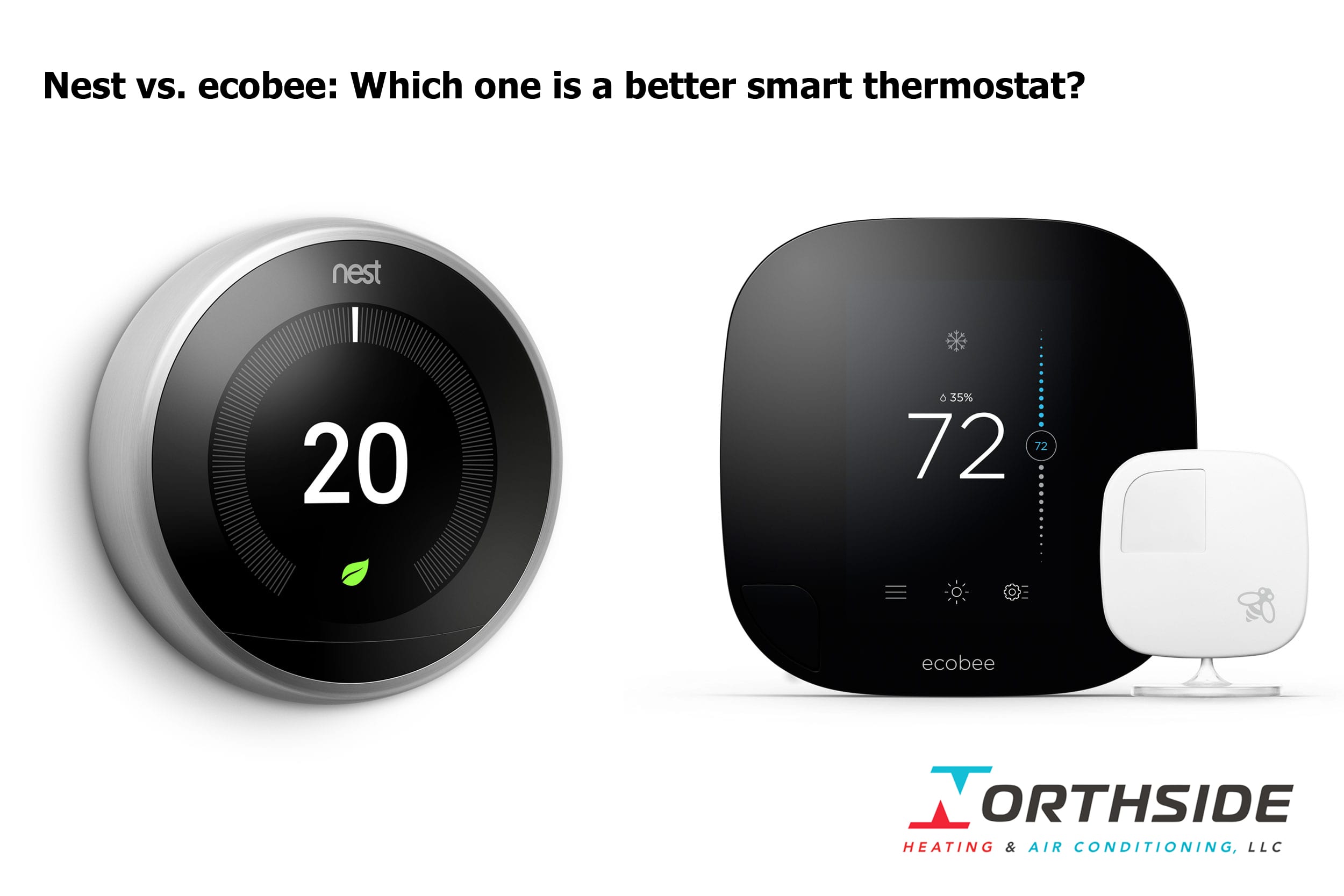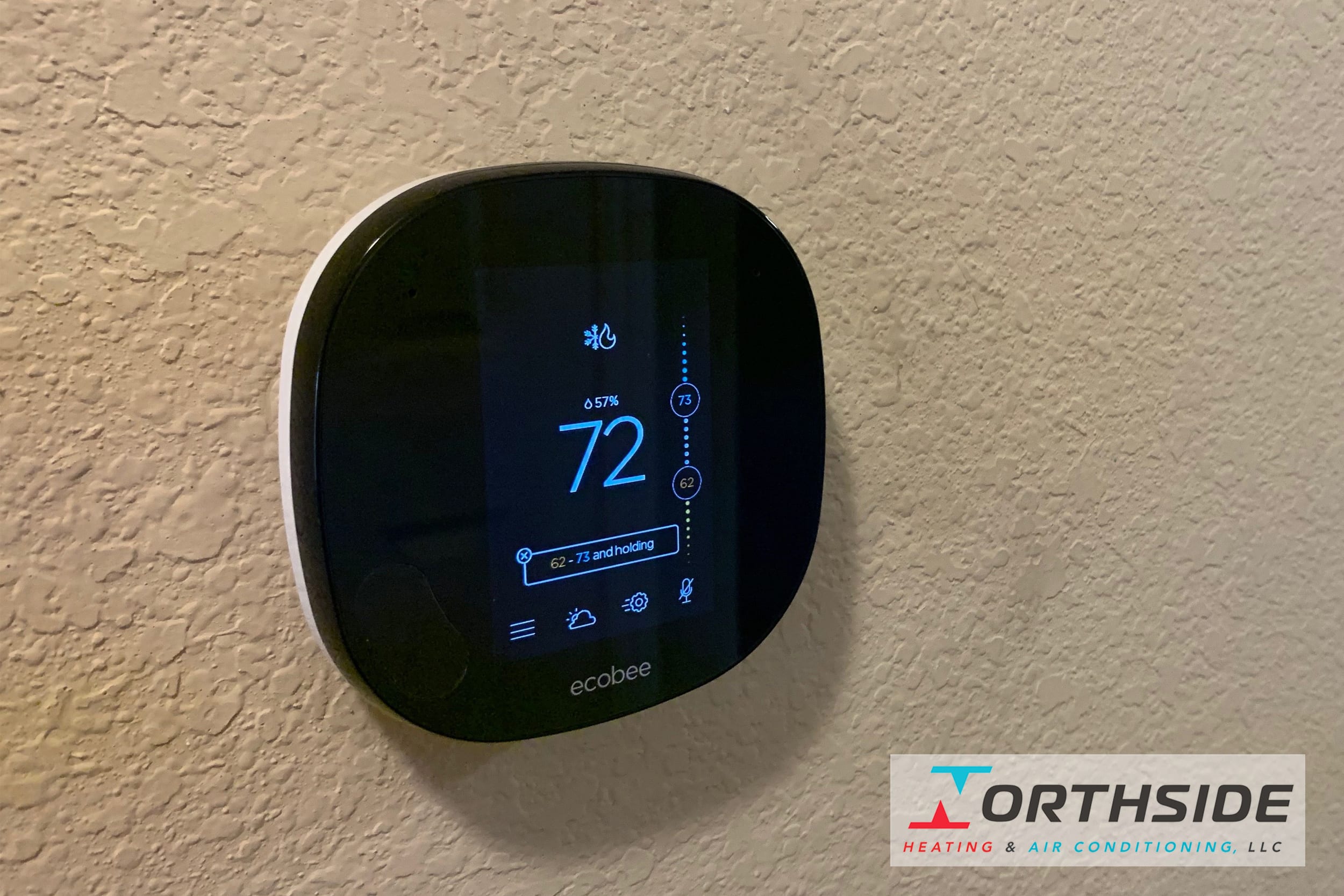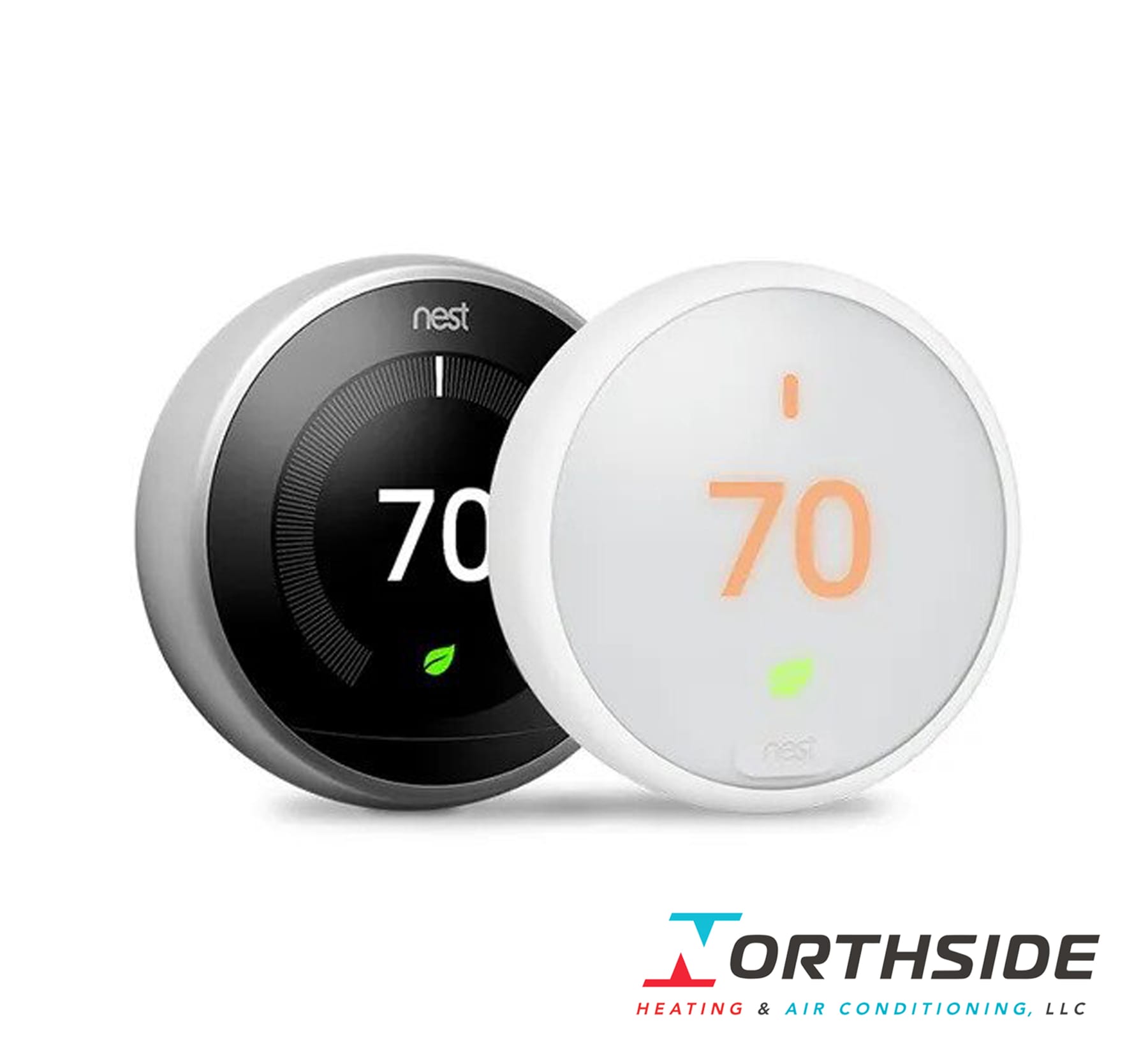
Just like any other kind of technology, there is not a simple answer. There is not “the best thermostat” or “the worst thermostat”; these two thermostats are just different; it all depends on the type of user you will be. The ecobee tends to be more robust when it comes to settings and personalization; ironically, it is closer to resembling the android operating system in your cell phone than on an iPhone, for example. We like to refer to the Nest Thermostat as the “Apple” of thermostats. The Nest tends to be very friendly and easy to use. When it comes to the user interface, the Nest Thermostat is friendlier than the ecobee. The ecobee tends to be more overwhelming and complicated than the Nest Thermostat. For usability, the Nest Thermostat looks to be better than the ecobee. The Nest is much easier to use. It seems that it is easier to control the temperature by just turning the ring around the Nest left or right instead of touching the screen on the ecobee and sliding your finger up and down. It may seem like a simple detail, but he makes a huge difference. We at Northside Heating & Air Conditioning strongly recommend that whichever thermostat you choose to install in your home, that you have it installed by a professional HVAC technician, preferably from Northside Heating & Air Conditioning, LLC. Some smaller configurations and settings can make your system behave erratically or out; turning a feature on or off can defeat the purpose of having a smart thermostat in the first place. Especially here in the South is where you will find most HVAC systems are available to customers. We mean by this that you will easily find split systems, package units, dual-fuel, geothermal, gas heat, oil heat, electrical heat, and much more. Virtually any available HVAC equipment out there can be found in this area of the country. This means that unless you know exactly what you are doing, the wrong thermostat configuration can cause serious problems.
Do I need a C wire for my ecobee? Do I need a C wire for my Nest?
 Although most thermostats do not require the “C” wire, it is essential to install one when you decide to upgrade. It is a known fact that sometimes installing the Nest Thermostat without a common wire can lead to problems. The ecobee comes with a special kit that allows you to add a common wire if one is not available; both of these thermostats require a common wire to complete a circuit. In any case, having a certified HVAC technician work on these thermostats is the best idea. A little known fact is that it is preferable to have a “C” wire every time a new thermostat is installed in your home. Regardless of the situation, a common wire can provide a more reliable performance from your thermostat, given that you will not need batteries. It is ubiquitous to find batteries that have failed and released acidic material into the internal parts of a thermostat; this happens when people forget to change the batteries regularly. Once the batteries go bad, there is nothing that can be done to the thermostat; this means that it will most likely be broken beyond repair. Here
Although most thermostats do not require the “C” wire, it is essential to install one when you decide to upgrade. It is a known fact that sometimes installing the Nest Thermostat without a common wire can lead to problems. The ecobee comes with a special kit that allows you to add a common wire if one is not available; both of these thermostats require a common wire to complete a circuit. In any case, having a certified HVAC technician work on these thermostats is the best idea. A little known fact is that it is preferable to have a “C” wire every time a new thermostat is installed in your home. Regardless of the situation, a common wire can provide a more reliable performance from your thermostat, given that you will not need batteries. It is ubiquitous to find batteries that have failed and released acidic material into the internal parts of a thermostat; this happens when people forget to change the batteries regularly. Once the batteries go bad, there is nothing that can be done to the thermostat; this means that it will most likely be broken beyond repair. Here
Air Conditioning Temperature Setting Energy-Saving
The purpose of having a smart thermostat is that you can forget about it. Both thermostats have the feature that knows when you are home or when you are away. Why would you be heating or cooling your house when no one is there, right? Of course, one has to be reasonable when setting the temperatures while you are away. It is not recommended to have more than 8°F temperature difference when turning your air conditioning system on and off. It is not good to make your HVAC unit “struggle” too much when trying to run it in your home; this can lead to premature failure and/or poor system performance. For those who are not familiarized with a geofencing thermostat, it is a very simple concept. Geofencing the thermostat means that when you leave your home the thermostat switches the temperature automatically by using a combination of GPS, Wi-Fi, or Bluetooth. These thermostats may also have IR sensors that can tell when someone walks by, thus allowing it to tell about someone’s presence. The Nest Thermostat seems to be the easiest experience since every phone in the home can be linked to the same account so if there is one person in the house and everybody has left the thermostat will be able to run normally and not switch the temperature. When it comes to the ecobee, the “away” feature can only be set up to one phone, so if you are married or have kids it will get a little bit more complicated to control the thermostat with geofencing. Both thermostats will walk you through the process once the thermostat is installed. Hopefully, you will have an HVAC technician to help you through the process.
Cooling and Air Conditioning
 Features involving cooling and heating go hand-in-hand; many of the benefits that you will get with the heating translate into cooling. We have explained in this post features for the heating more extensively because it is more complex. By covering the heating aspect of smart thermostats, you can understand the cooling as well. Cooling your house in the middle of summer will benefit from the away features just as well as the heating mode. Unlike heating, the most important thing to keep you comfortable at home is controlling the humidity, and this is where these thermostats shine. The old thermostats do not come with a humidistat built-in. To say that it is important to know the humidity range in your home is an understatement. This can easily explain why in places like California, even when the temperature outside is 92° it feels very comfortable. Unlike the West, in the South, even if the temperatures outside only 86°F it can still feel extremely hot, this is due to the high levels of humidity. Fortunately, geofencing thermostats can address this by calculating how long the unit has to run in order to keep the humidity levels manageable. The Nest thermostat has a feature called “air to cool”, in which the air conditioning unit will run for longer periods of time to “over cool” the air in order to reduce humidity inside the home. What this means is that the air can be cooled up to 2°F lower than the setpoint just to achieve a lower humidity level. The ecobee geofencing thermostat takes it one step further with the “A/C Overcool Max”, which can bring the temperature lower than setpoint by 5°F. As you can see, controlling the humidity level inside your home is a very important feature; we would recommend that you do NOT use these features unless it is strictly necessary. Oftentimes if you are having humidity troubles in your home, there could be something wrong with your HVAC system, or the classic problem, which is having an oversized unit for your home. In HVAC, bigger doesn’t mean better. Luckily these smart thermostats can help mitigate some of these problems. We, at Northside Heating & Air Conditioning, like to mention that many of the very expensive air conditioning units feature some of these functions. In other words, you can “upgrade” your unit very inexpensively without breaking the bank.
Features involving cooling and heating go hand-in-hand; many of the benefits that you will get with the heating translate into cooling. We have explained in this post features for the heating more extensively because it is more complex. By covering the heating aspect of smart thermostats, you can understand the cooling as well. Cooling your house in the middle of summer will benefit from the away features just as well as the heating mode. Unlike heating, the most important thing to keep you comfortable at home is controlling the humidity, and this is where these thermostats shine. The old thermostats do not come with a humidistat built-in. To say that it is important to know the humidity range in your home is an understatement. This can easily explain why in places like California, even when the temperature outside is 92° it feels very comfortable. Unlike the West, in the South, even if the temperatures outside only 86°F it can still feel extremely hot, this is due to the high levels of humidity. Fortunately, geofencing thermostats can address this by calculating how long the unit has to run in order to keep the humidity levels manageable. The Nest thermostat has a feature called “air to cool”, in which the air conditioning unit will run for longer periods of time to “over cool” the air in order to reduce humidity inside the home. What this means is that the air can be cooled up to 2°F lower than the setpoint just to achieve a lower humidity level. The ecobee geofencing thermostat takes it one step further with the “A/C Overcool Max”, which can bring the temperature lower than setpoint by 5°F. As you can see, controlling the humidity level inside your home is a very important feature; we would recommend that you do NOT use these features unless it is strictly necessary. Oftentimes if you are having humidity troubles in your home, there could be something wrong with your HVAC system, or the classic problem, which is having an oversized unit for your home. In HVAC, bigger doesn’t mean better. Luckily these smart thermostats can help mitigate some of these problems. We, at Northside Heating & Air Conditioning, like to mention that many of the very expensive air conditioning units feature some of these functions. In other words, you can “upgrade” your unit very inexpensively without breaking the bank.
Cooling and Air Conditioning
This is a function for a heat pump; people who own these systems are very familiar with. It is the infamous “auxiliary heat”. It is well known that when a heat pump runs with the auxiliary heat on it consumes much more power, up to three times more, to be exact, depending on the size of your system. These old thermostats, aka “dumb thermostats”, will not help your power bill. In order to control the auxiliary heat more efficiently, the thermostat has to have the ability to know what the temperature outside is. Once the temperature outside is known, a calculation can be made in order to provide the best comfort for the least amount of energy. Geofencing thermostats in general, in this case, the ecobee and the Nest Thermostat, have the ability to know the temperature inside and outside your home; even more, they know the humidity levels inside your home as well. How do they do this you may ask? It is very simple; they are connected to the Internet through Wi-Fi. An Internet connection allows them to know the temperature, the weather, and everything else necessary to make you comfortable. When it comes to the emergency heat, the problem is: when you have a heat pump, an old thermostat will turn this heat source on when it is not necessary. For example, if you get home and your thermostat is set at 68°F, and you change it to 71°F you will have more than 2°F temperature difference. Your old thermostat will automatically bring the auxiliary heat on even if the temperature outside is warm. This is very counterproductive and wasteful. On the other hand, and it is the case for the ecobee and the Nest Learning Thermostat, you can set them up so the auxiliary heat will not come on unless the temperature outside is below a certain range. For example, you can set up in Nest Thermostat to NOT use the auxiliary heat unless the temperature outside is 40°F or less. If in the whole month of November the temperature outside never drops below 40°F, you will not use the auxiliary heat at all, period. This is actually quite amazing, it is almost like a safety guard for wasting money. Your heat pump should have the ability to heat your house no problem when the weather is relatively warm. These are two common cases for when your auxiliary heat should kick on. It should turn on when the unit goes into what is called a “defrost cycle”. This is when the heat pump must run in the cooling mode in order to heat the coil outside your home in order to get rid of ice buildup. This is something that cannot be controlled by the thermostat, and it is completely normal. The other common case is when the temperature outdoors is really low, and the unit has trouble heating your house. It is important to mention that regardless of the type of thermostat they use at home when it gets extremely cold or hot outside, any system will run for an extended period of time. In other words, you cannot expect to set your smart thermostat at 78°F and expect your unit not to run for a long time, thus increasing your power bill. The tool is almost as good as you are able to use it.



